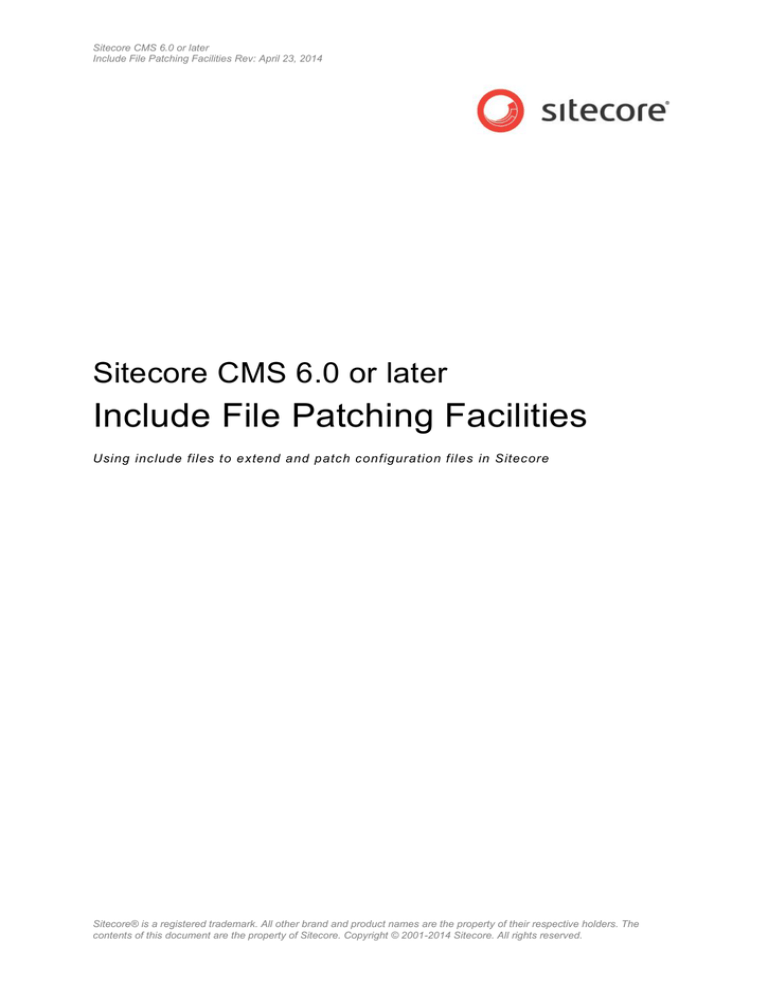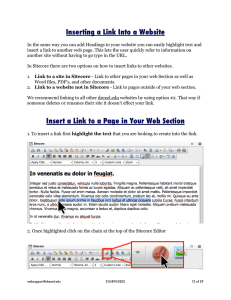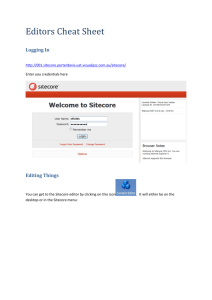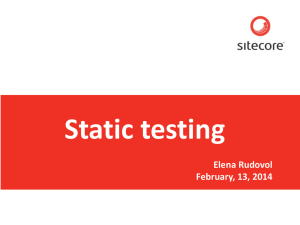
Sitecore CMS 6.0 or later
Include File Patching Facilities Rev: April 23, 2014
Sitecore CMS 6.0 or later
Include File Patching Facilities
Using include files to extend and patch configuration files in Sitecore
Sitecore® is a registered trademark. All other brand and product names are the property of their respective holders. The
contents of this document are the property of Sitecore. Copyright © 2001-2014 Sitecore. All rights reserved.
Sitecore CMS 6.0 or later
Introduction
The main purpose of the include file mechanism is to extend and patch Sitecore configuration files.
Include files allow you to introduce new settings, properties, and configuration nodes, as well as
override the values of existing settings, properties and configuration nodes.
There is a special XML syntax that allows you to perform common operations, such as:
Inserting a node into a defined place.
Modifying an attribute value.
Removing a node.
This document describes this process in more detail.
Sitecore® is a registered trademark. All other brand and product names are the property of their respective holders. The
contents of this document are the property of Sitecore. Copyright © 2001-2014 Sitecore. All rights reserved.
Page 2 of 18
Include File Patching Facilities
General Concepts
XML Namespaces and Node Names
All the attributes and elements that are related to patching are located inside the following XML
namespaces:
patch – http://www.sitecore.net/xmlconfig/
set – http://www.sitecore.net/xmlconfig/set/
You must declare the namespaces before you can use them in an include file. Normally, they are
declared at the beginning of the file:
<configuration xmlns:patch="http://www.sitecore.net/xmlconfig/"
xmlns:set="http://www.sitecore.net/xmlconfig/set/">
. . . . .
. . . . .
</configuration>
In this scenario, you use the patch: and set: prefixes to access the nodes that control patching.
Useful terminology:
Term
Definition
Node
An XML document is a node tree. A node can be an element
node, an attribute node, a text node, and so on.
Element
A logical document component which either begins with a
start-tag and ends with a matching end-tag or only contains
an empty-element tag, for example, <element />.
Attribute
A markup construct that consists of a name/value pair that
exists within a start-tag or empty-element tag, for example,
<element attribute=”value” />.
For more information about XML namespaces, see Wikipedia —
http://en.wikipedia.org/wiki/XML_namespace.
The Include Directory and *.config files
Sitecore reads the configuration files in the following order to build up the actual configuration to use:
The web.config file.
All of the *.config files from the /App_config/Include folder. These files extend and
modify the content of the <sitecore /> node in the web.config file.
The files in the /App_Config/Include folder are applied sequentially by file name. Sitecore
therefore applies the AName.config file before the ZName.config file. The order in which the
include files are applied doesn’t really matter. However, if the same setting (or node) is modified in
more than one include file, only the last modification is accepted. Furthermore, if you want to patch a
node that is added from another include file, you must ensure that the include file with the patch is
applied after the include file that adds the node.
Sitecore® is a registered trademark. All other brand and product names are the property of their respective holders. The
contents of this document are the property of Sitecore. Copyright © 2001-2014 Sitecore. All rights reserved.
Page 3 of 18
Sitecore CMS 6.0 or later
Sitecore only takes *.config files into account. If you need to disable a particular *.config file,
you can change its extension. We recommend that you change the file name to
*.config.disabled.
When Sitecore reads the include files, it traverses the file system recursively. Sitecore first
enumerates all the *.config files in the /App_Config/Include folder and then recursively
enumerates all the sub-folders. You should take this order into account when you create sub-folders
in the /App_Config/Include folder.
Processing Include Files
When Sitecore applies the changes from an include file, it recursively traverses all the elements in the
include file starting from the root and tries to match each element to an element in the existing
configuration.
Sitecore uses the element’s name and all its attributes to match the nodes. To match the elements in
the include files with the corresponding elements in the web.config file, your include files must
specify in a unique way which nodes and/or attributes should be modified.
When Sitecore processes a particular element, there are two options:
The element already exists and Sitecore modifies its content.
The element does not exist and Sitecore inserts this new element.
Sitecore uses the following comparison algorithm:
1. Sitecore takes an element from an include file and extracts all its attributes with their values.
When matching elements, all the nodes from the set and patch namespaces and the
namespace declarations are ignored — for example, <element xmlns:customNs=”..”
/>.
2. Sitecore checks whether an element at the same level with the same name and attribute
values exists in the original document.
3. If more than one node with these constraints exists, Sitecore selects the first of these nodes.
For instance, if we specify the <processor /> element in the include file, only the first
processor in the web.config file is selected.
4. If no node matches the constraints, Sitecore inserts the new element instead of patching an
existing node.
Sitecore uses the attributes and their values as constraints to determine which specific node to
change. If you do not specify enough attributes, the wrong element may be matched. For example,
technically it is possible that a few event handlers have the same type attribute values but different
method attribute values. If you only specify the type attribute, Sitecore will match the first event
handler. On the other hand, if you specify redundant attribute values, Sitecore might not match any
node if its attribute values were changed in the original document, for example in the web.config file
or in the previous include file. Every time you create an include file, you must analyze which attributes
you want to include and which you want to omit.
Example
This example should help you to understand the rules.
The following configuration is defined in the web.config file:
<configuration>
<sitecore>
<events timingLevel="custom">
<event name="item:added" />
<event name="item:removed">
<handler type="ItemEventHandler" method="OnItemRemoved" />
<handler type="ItemEventHandler" method="OnItemChanged" />
Sitecore® is a registered trademark. All other brand and product names are the property of their respective holders. The
contents of this document are the property of Sitecore. Copyright © 2001-2014 Sitecore. All rights reserved.
Page 4 of 18
Include File Patching Facilities
</event>
</events>
<settings>
<setting name="AliasesActive" value="true" />
<setting name="AllowLogoutOfAllUsers" value="false" />
</settings>
</sitecore>
</configuration>
You want to remove the OnItemChanged event handler and change the value of the
AllowLogoutOfAllUsers setting to true.
The content of the include file could be:
<configuration xmlns:patch=http://www.sitecore.net/xmlconfig/
xmlns:set="http://www.sitecore.net/xmlconfig/set/">
<sitecore>
<events>
<event name="item:removed">
<handler type="ItemEventHandler" method="OnItemChanged" >
<patch:delete />
</handler>
</event>
</events>
<settings>
<setting name="AllowLogoutOfAllUsers" >
<patch:attribute name="value" value="true" />
</setting>
</settings>
</sitecore>
</configuration>
Ignore the patch specific nodes for a moment — they are described later in this document.
Notice how the event handler and the setting are specified.
Let’s analyze the XML document.
The sitecore element does not require any constrains because there is only one available
sitecore element.
The original events element contains the timingLevel attribute.
This attribute is ignored because there is only one events node and ambiguity is impossible.
Furthermore, you should not specify the timingLevel attribute because if you change the
timingLevel value in the web.config file, Sitecore will not be able to match it in the
future.
There are several event elements and you should therefore use the name attribute to identify
the exact element that you mean.
For the handler element, the example uses both the type and method attributes.
It is not enough to only use the type attribute because the OnItemRemoved handler would
be matched in this case. Only using the method attribute would be sufficient, because there
are no other handlers that contain this method.
However, it goes against the logic — the type and method pairing represents a handler —
and could cause problems if you introduce another handler with the same method attribute
value.
For the settings element, the example doesn’t use any attributes, because only one such
node exists.
For the setting element, the example only uses the name attribute value.
If you add the value attribute, it will work fine until you change the value in the web.config
file or in any preceding include files.
Sitecore® is a registered trademark. All other brand and product names are the property of their respective holders. The
contents of this document are the property of Sitecore. Copyright © 2001-2014 Sitecore. All rights reserved.
Page 5 of 18
Sitecore CMS 6.0 or later
The resulting configuration is:
<configuration>
<sitecore>
<events timingLevel="custom">
<event name="item:added" />
<event name="item:removed">
<handler type="ItemEventHandler" method="OnItemRemoved" />
</event>
</events>
<settings>
<setting name="AliasesActive" value="true" />
<setting name="AllowLogoutOfAllUsers" value="true" />
</settings>
</sitecore>
</configuration>
The Resulting Configuration (showconfig.aspx)
When Sitecore starts, it reads the configuration files and merges them to produce the resulting XML
document. The resulting configuration document is stored in memory, and Sitecore uses it every time
it needs some configuration values. Use the showconfig.aspx page to view the resulting XML file.
The URL is: http://hostName/sitecore/admin/showconfig.aspx.
To check the actual configuration, we recommend that you look at the showconfig.aspx page
rather than the web.config file and the stand-alone include files.
Troubleshooting
The main tool that you can use to troubleshoot the patching functionality is the showconfig.aspx
page. It allows to see how each include file affected the whole configuration.
To troubleshoot the include facilities more effectively, the patch:source attribute was introduced in
Sitecore 7.0. This attribute indicates the name of the include file that last altered the current node.
The main properties of the patch:source attribute are:
It is added to nodes where one or more attributes have been added or modified by an include
file.
If several include files have modified attributes on a node, the patch:source attribute will
only indicate the name of the last include file that applied changes to the node.
The attribute is omitted if none of the include files modified the node.
This attribute is displayed in the /sitecore/admin/showconfig.aspx page and does not affect
the actual configuration.
Sitecore® is a registered trademark. All other brand and product names are the property of their respective holders. The
contents of this document are the property of Sitecore. Copyright © 2001-2014 Sitecore. All rights reserved.
Page 6 of 18
Include File Patching Facilities
The Patch Namespace
(http://www.sitecore.net/xmlconfig/)
Overview
The patch namespace contains two types of nodes:
Attributes — <elem patch:attribute="" … />
Elements — <patch:element …. />
To access these nodes, you must define the http://www.sitecore.net/xmlconfig/ and
http://www.sitecore.net/xmlconfig/set/ namespaces. Although you can specify any
aliases for the namespaces, patch and set are usually used:
<configuration xmlns:patch="http://www.sitecore.net/xmlconfig/"
xmlns:set=”http://www.sitecore.net/xmlconfig/set/”>
Attribute Nodes
Normally when you introduce a new element, it is appended at the end of its parent element. The
attribute nodes of the patch namespace are used to determine the relative position of the inserted
element. Normally these attributes are only used when you introduce new elements. These attributes
are not designed for moving existing elements.
There are three attributes in this namespace:
patch:before
patch:after
patch:instead
The attributes nodes are used to specify the relative position of the current node. The anchor nodes
are specified as attribute values in XPath. The XPath is evaluated using the parent element as the
context item. Each attribute has a short alias that you can use instead of its long name.
patch:before
Use this attribute to specify that the current element should be inserted before a sibling element.
Short alias: b
Syntax
<processor type=”CustomC, CustomA” patch:before=”*[@type=’Sc, Sc]’” />
<processor type=”CustomC, CustomA” patch:b=”*[@type=’Sc, Sc]’” />
Example
Original configuration:
<configuration>
<sitecore>
Sitecore® is a registered trademark. All other brand and product names are the property of their respective holders. The
contents of this document are the property of Sitecore. Copyright © 2001-2014 Sitecore. All rights reserved.
Page 7 of 18
Sitecore CMS 6.0 or later
<element name="a"/>
<element name="b"/>
<element name="c"/>
</sitecore>
</configuration>
Include file:
<configuration xmlns:patch="http://www.sitecore.net/xmlconfig/"
xmlns:set=”http://www.sitecore.net/xmlconfig/set/”>
<sitecore>
<element name="d" patch:before="*[@name=b]"/>
</sitecore>
</configuration>
Resulting configuration:
<configuration>
<sitecore>
<element name="a"/>
<element name="d"/>
<element name="b"/>
<element name="c"/>
</sitecore>
</configuration>
patch:after
Use this attribute to specify that the current element should be inserted after a sibling element.
Short alias: a
Syntax
<processor type=”CustomC, CustomA” patch:after=”*[@type=’Sc, Sc]’” />
<processor type=”CustomC, CustomA” patch:a=”*[@type=’Sc, Sc]’” />
Example
Original configuration:
<configuration>
<sitecore>
<element name="a"/>
<element name="b"/>
<element name="c"/>
</sitecore>
</configuration>
Include file:
<configuration xmlns:patch="http://www.sitecore.net/xmlconfig/"
xmlns:set=”http://www.sitecore.net/xmlconfig/set/”>
<sitecore>
<element name="d" patch:after="*[@name=b]"/>
</sitecore>
</configuration>
Resulting configuration:
<configuration>
<sitecore>
<element name="a"/>
<element name="b"/>
<element name="d"/>
<element name="c"/>
</sitecore>
</configuration>
Sitecore® is a registered trademark. All other brand and product names are the property of their respective holders. The
contents of this document are the property of Sitecore. Copyright © 2001-2014 Sitecore. All rights reserved.
Page 8 of 18
Include File Patching Facilities
patch:instead
Use this attribute to specify that the current element should be inserted instead of a sibling element.
Unlike patch:before and patch:after, this attribute allows you to completely replace the original
node or element.
Short alias: i
Syntax
<processor type=”CustomC, CustomA” patch:instead=”*[@type=’Sc, Sc]’” />
<processor type=”CustomC, CustomA” patch:i=”*[@type=’Sc, Sc]’” />
Example
Original configuration:
<configuration>
<sitecore>
<element name="a"/>
<element name="b"/>
<element name="c"/>
</sitecore>
</configuration>
Include file:
<configuration xmlns:patch="http://www.sitecore.net/xmlconfig/"
xmlns:set=”http://www.sitecore.net/xmlconfig/set/”>
<sitecore>
<element name="d" patch:instead="*[@name=b]"/>
</sitecore>
</configuration>
Resulting configuration:
<configuration>
<sitecore>
<element name="a"/>
<element name="d"/>
<element name="c"/>
</sitecore>
</configuration>
Element Nodes
Element nodes are tags from the patch namespace that are applied to their parents. This means that
the <patch:delete/> and <patch:attribute …/> elements only affect the parent element
which surrounds them. These nodes cannot contain child elements. If they contain child elements,
they are ignored.
The patch namespace contains two element nodes:
patch:delete
patch:attribute
If you specify a non-existing element name, the element will be ignored. These nodes have aliases
that you can use instead of their full names.
patch:delete
This element is a marker that indicates that the parent node should be removed. You should not
specify any attributes or inner elements.
Short alias: d
Sitecore® is a registered trademark. All other brand and product names are the property of their respective holders. The
contents of this document are the property of Sitecore. Copyright © 2001-2014 Sitecore. All rights reserved.
Page 9 of 18
Sitecore CMS 6.0 or later
Syntax
<elementToRemove>
<patch:delete />
<!-- or -->
<patch:d />
</elementToRemove>
Example
Original configuration:
<configuration>
<sitecore>
<element name="a"/>
<element name="b"/>
<element name="c"/>
</sitecore>
</configuration>
Include file:
<configuration xmlns:patch="http://www.sitecore.net/xmlconfig/"
xmlns:set=”http://www.sitecore.net/xmlconfig/set/”>
<sitecore>
<element name="b">
<patch:delete />
</element>
</sitecore>
</configuration>
Resulting configuration:
<configuration>
<sitecore>
<element name="a"/>
<element name="c"/>
</sitecore>
</configuration>
In this example, to identify which exact element should be removed, you must specify the name
attribute for the element node in the include file. If you omit the name attribute, the first element is
removed — in this example, the one named a.
patch:attribute
This element is used to modify the value of an attribute of the parent element. Usually it is used to
change the value of a setting or to change the type attribute. Changing the type attribute of pipeline
processors or event handlers is often useful when you want to override parts of the default Sitecore
functionality.
Short alias: a
Syntax
<elementToAlter>
<patch:attribute name="parentAttributeName" value="newAttributeValue" />
<!—- or -->
<patch:a name="parentAttributeName" value="newAttributeValue" />
</elementToAlter>
Alternative syntax:
<elementToAlter>
<patch:attribute name="parentAttributeName">
newAttributeValue
</patch:attribute>
<!—- or -->
<patch:a name="parentAttributeName">
newAttributeValue
Sitecore® is a registered trademark. All other brand and product names are the property of their respective holders. The
contents of this document are the property of Sitecore. Copyright © 2001-2014 Sitecore. All rights reserved.
Page 10 of 18
Include File Patching Facilities
</patch:a>
</elementToAlter>
Attribute
Description
name
The name of the parent attribute whose value
should be changed.
value
The new value that should be assigned to the
parent attribute.
In many cases, using set: prefix is more convenient than using patch:attribute.
For more information about set:prefix see *****
Example
Original configuration:
<configuration>
<sitecore>
<element name="a"/>
<element name="b"/>
<element name="c"/>
</sitecore>
</configuration>
Include file:
<configuration xmlns:patch="http://www.sitecore.net/xmlconfig/">
<sitecore>
<element name="b">
<patch:attribute name="name" value="d" />
</element>
</sitecore>
</configuration>
Resulting configuration:
<configuration>
<sitecore>
<element name="a"/>
<element name="d"/>
<element name="c"/>
</sitecore>
</configuration>
Sitecore® is a registered trademark. All other brand and product names are the property of their respective holders. The
contents of this document are the property of Sitecore. Copyright © 2001-2014 Sitecore. All rights reserved.
Page 11 of 18
Sitecore CMS 6.0 or later
The Set Namespace
(http://www.sitecore.net/xmlconfig/set/)
Overview
The set namespace is used to override attribute values. This namespace does not contain any
predefined elements or attributes and can only be applied to attribute nodes.
The set namespace duplicates the functionality of the patch:attribute element. However, the
set namespace is often more convenient to use because it allows you to set an attribute to a specific
value, regardless of whether the attribute is already present in the node or not.
The set namespace prefix indicates that you want to override the current attribute value of the
current element. It says set the value of this attribute to the specified value, no matter what it was
before. If this attribute is not there already, introduce it. You want to have this attribute with the
specified value.
When Sitecore compares elements and attributes to identify which node to patch, it ignores attributes
which start with the set namespace prefix. You must therefore be careful when you use this
namespace because a single element can contain more than one attribute with the same name. In
this situation, you must specify the attribute and value without the set: prefix to identify the node to
patch and then specify the attribute with the set: prefix to alter the attribute value. For example
<element attr="a" set:attr="b" />.
Before you use the set namespace, you must define the
http://www.sitecore.net/xmlconfig/set/ XML namespace.
For more information about node matching, see the section Processing Include Files.
Syntax
<configuration xmlns:patch="http://www.sitecore.net/xmlconfig/
xmlns:set=http://www.sitecore.net/xmlconfig/set/>
<element attr1="value1" attr2="value2" set:attr3="newValue" />
</configuration>
If the original element node contains the attr3 attribute, the value is replaced by newValue. If the
original element does not contain this attribute, it is introduced.
Examples
Original configuration:
<configuration>
<sitecore>
<element name="a"
<element name="b"
<element name="c"
<element name="c"
</sitecore>
</configuration>
color="blue" />
color="gray"/>
color="red" />
color="blue"/>
You want to change the color attribute for the b element.
The include file should identify the node itself and contain the color attribute with a new value. You
must use the set prefix with the color attribute.
Sitecore® is a registered trademark. All other brand and product names are the property of their respective holders. The
contents of this document are the property of Sitecore. Copyright © 2001-2014 Sitecore. All rights reserved.
Page 12 of 18
Include File Patching Facilities
Include file:
<configuration xmlns:patch="http://www.sitecore.net/xmlconfig/
xmlns:set="http://www.sitecore.net/xmlconfig/set/">
<sitecore>
<element name="b" set:color="yellow"/>
</sitecore>
</configuration>
Resulting configuration:
<configuration>
<sitecore>
<element name="a"
<element name="b"
<element name="c"
<element name="c"
</sitecore>
</configuration>
color="blue" />
color="yellow"/>
color="red" />
color="blue"/>
The name="b" attribute is used to identify the correct element — because there are a few. The
set:color="yellow" attribute combined with the set namespace prefix is used to alter the value of
the existing color attribute.
Let’s do a trickier change.
You want to change the blue color to violet in the following element:
<element name="c" color="blue" />
You can’t use only the name or the color attribute because this will lead to ambiguity and Sitecore
will select the first node that matches the specified attribute values.
To identify the node, you must use both the name and the color attributes. The element in the
include file must also contain the set namespace with a new value for the color attribute.
Include file:
<configuration xmlns:patch="http://www.sitecore.net/xmlconfig/
xmlns:set="http://www.sitecore.net/xmlconfig/set/">
<sitecore>
<element name="c" color=”blue” set:color="violet"/>
</sitecore>
</configuration>
Resulting configuration:
<configuration>
<sitecore>
<element name="a"
<element name="b"
<element name="c"
<element name="c"
</sitecore>
</configuration>
color="blue" />
color="gray"/>
color="red" />
color="violet"/>
The include file used the name="c" and the color=”blue” attributes to identify the node and used
the set:color="violet" attribute to change the attribute value.
Sitecore® is a registered trademark. All other brand and product names are the property of their respective holders. The
contents of this document are the property of Sitecore. Copyright © 2001-2014 Sitecore. All rights reserved.
Page 13 of 18
Sitecore CMS 6.0 or later
Multiple Approaches to Solving the Same Task
In the section about the set namespace, we explained that all the functionality of the
patch:attribute can be achieved with the set namespace. Furthermore, we explained that the
same task can be done in several different ways. Let’s demonstrate this.
Example
You have the following configuration from Email Campaign Manager:
<configuration>
<sitecore>
<TypeResolver
type="Sitecore.Modules.EmailCampaign.Core.TypeResolver,Sitecore.EmailCampaign"
singleInstance="true" />
</sitecore>
</configuration>
You want to override the default type resolver and set the custom type value to the type attribute.
There are several approaches to this task:
Approach #1: Using patch:delete & insert new
The most direct approach is to remove the whole TypeResolver node and specify a custom one.
This can be done with the following include file:
<configuration xmlns:patch="http://www.sitecore.net/xmlconfig/" >
<sitecore>
<TypeResolver>
<patch:delete />
</TypeResolver>
<TypeResolver type="CustomTypeResolver, Custom" singleInstance="true" />
</sitecore>
</configuration>
Approach #2: Using patch:instead
You can also use the patch:instead attribute to insert a custom TypeResolver element instead
of the default one:
<configuration xmlns:patch="http://www.sitecore.net/xmlconfig/" >
<sitecore>
<TypeResolver type="CustomTypeResolver, Custom" singleInstance="true"
patch:instead="TypeResolver" />
</sitecore>
</configuration>
Approach #3: Using patch:attribute
The patch:attribute node allows us to modify the type attribute only and doesn’t affect the other
attributes, for example singleInstance. You can therefore also use it:
<configuration xmlns:patch="http://www.sitecore.net/xmlconfig/" >
<sitecore>
<TypeResolver>
<patch:attribute name="type">
CustomTypeResolver, Custom
</patch:attribute>
</TypeResolver>
</sitecore>
</configuration>
Sitecore® is a registered trademark. All other brand and product names are the property of their respective holders. The
contents of this document are the property of Sitecore. Copyright © 2001-2014 Sitecore. All rights reserved.
Page 14 of 18
Include File Patching Facilities
Approach #4: Using Set namespace
If you can achieve this result with the patch:attribute node, you can do the same with the set
namespace. The include file could be:
<configuration xmlns:set="http://www.sitecore.net/xmlconfig/set/">
<sitecore>
<TypeResolver set:type="CustomTypeResolver, Custom" />
</sitecore>
</configuration>
No matter which method you chose, the final configuration is the same:
<configuration>
<sitecore>
<TypeResolver type="CustomTypeResolver, Custom" singleInstance="true" />
</sitecore>
</configuration>
Choosing a Method
You can use any of the methods described in this document to achieve your goal. However, we do
not recommend all of these methods.
The first two approaches — using patch:delete/patch:insert or using patch:instead —
completely override the TypeResolver element. They override the singleInstance attribute
value and ignore its old value
If you change the original attribute value in the web.config file or any of the preceding include files,
the actual value is not affected. The probability of this particular change is relatively low, so in this
case it is a matter of taste.
However, there are places when it would be a mistake to follow this approach. For instance, if you
want to override the database type:
<database id="master" singleInstance="true" type="Sitecore.Data.Database, Sitecore.Kernel">
. . . . . . . .
</database>
In this particular case, you must bring the whole node to the include file. Some preceding include files
can affect the database settings, for example, tune caches sizes or specify custom engines and these
changes will be ignored if you replace the entire node. You should therefore be careful when you
decide which approach to use.
In the previous example, the last two approaches — using patch:attribute or the set
namespace — are more elegant because they only affect the type attribute. The set namespace
method requires less text and seems simpler. We therefore recommend any of the last two
approaches.
Before you choose an approach, we recommend that you always consider the alternative
approaches. In an ideal world, the approach you choose should affect only the attributes/elements
that you are interested in and rely on a minimal number of other values.
Sitecore® is a registered trademark. All other brand and product names are the property of their respective holders. The
contents of this document are the property of Sitecore. Copyright © 2001-2014 Sitecore. All rights reserved.
Page 15 of 18
Sitecore CMS 6.0 or later
Best Practices
Only Use CMS Patching Facilities to Alter CMS Configuration
The overwhelming majority of the Sitecore related configuration settings are located in the
<sitecore /> section of the application’s configuration file. Sitecore incrementally applies
*.config files to the <sitecore /> section so any node inside that section could be easily
overridden by any include file. It’s highly recommended that you use the patching functionality to
modify the resulting CMS configuration rather than modify it directly in the preinstalled configuration
files, for example, the web.config or the Sitecore.Analytics.config file.
Using the include files has a number of benefits:
It is much easier to track the places that modify CMS configuration and revert them if need.
If the configuration is modified through the custom *.config files, you just need to rename
those files to get back to the default CMS configuration.
It is much easier to upgrade your CMS installation when you deploy your custom settings into
a plain CMS installation.
It is much easier to detect and troubleshoot customizations which affect particular pieces of
CMS functionality.
There is less chance that you will break the functionality of CMS modules.
For instance, some modules deploy their own custom *.config files to extend CMS
functionality with custom configurations. As we know, patching commands often require exact
node values to work properly, for example, type attribute values. If you modify the default
values directly in the web.config file, the patching functionality will not work as expected
and the module could get broken. Of course, using patching facilities doesn’t prevent these
issues — the value could be altered by a preceding include file — but it is much easier to
identify them if you only use *.config files to alter the configuration.
Because of the benefits it’s recommended that you use include files to alter the configuration in the
following situations:
When modifying the default CMS or modules setting values, object types, and so on.
When introducing new processors, settings, providers, and so on.
We recommend that you name custom *.config files with the name of your company/project and
also that you include a short description of the changes that the file applies.
For example, if you want to alter the title on the Sitecore login page, the include file could be:
Include file name: MyCompany.WelcomeTitle.config
Include file content:
<configuration xmlns:patch="http://www.sitecore.net/xmlconfig/"
xmlns:set="http://www.sitecore.net/xmlconfig/set/">
<sitecore>
<settings>
<setting name="WelcomeTitle" set:value="Welcome to MyCompany" />
</settings>
</sitecore>
</configuration>
Sitecore® is a registered trademark. All other brand and product names are the property of their respective holders. The
contents of this document are the property of Sitecore. Copyright © 2001-2014 Sitecore. All rights reserved.
Page 16 of 18
Include File Patching Facilities
Add New Processors to Pipelines rather than Modify the Existing
Ones
If you need to modify the behavior in a pipeline, it is often enough to just alter the value of some of the
pipeline arguments. In these cases, it’s preferable to introduce a custom processor rather than rewrite
the existing one.
This approach has some positive effects:
It’s much easier to upgrade your solution, because there are less chances that something will
get broken.
There is greater compatibility with other components which rewrite the same processor.
Sometimes modules replace processors with custom ones. If you rewrite the processor, it is
likely that the module will break.
For example, if the context item wasn’t resolved by the default item resolver, you may need to resolve
it in a special way. It would be nice to just add a custom item resolver immediately after the default
one and have this do the work if the context item is null — the item was not resolved:
Web.config file content:
<httpRequestBegin>
...
<processor type="Sitecore.Pipelines.HttpRequest.ItemResolver, Sitecore.Kernel" />
...
</httpRequestBegin
Include file name:
\App_Config\Include\MyCompany.ItemResolver.config
Include file content:
<configuration xmlns:patch="http://www.sitecore.net/xmlconfig/">
<sitecore>
<pipelines>
<httpRequestBegin>
<processor type="MyCompany.ItemResolver, MyCompany"
patch:after="*[@type='Sitecore.Pipelines.HttpRequest.ItemResolver, Sitecore.Kernel']" />
</httpRequestBegin>
</pipelines>
</sitecore>
</configuration>
Always Add New Provider Rather than Modify the Type of the
Default
If you need to extend the logic of an existing provider, for example,
Sitecore.Security.Authentication.FormsAuthenticationProvider, we strongly
recommended that you add a new provider with the altered logic rather than replace the type of the
default one. This increases the supportability of the product and allows you to quickly switch to the
default provider.
To introduce new provider, we recommend that you use this approach:
Initial configuration:
<configuration>
<sitecore>
<authentication defaultProvider="forms">
<providers>
<clear/>
<add name="forms" type="Sitecore.Security.Authentication.FormsAuthenticationProvider,
Sitecore.Kernel"/>
Sitecore® is a registered trademark. All other brand and product names are the property of their respective holders. The
contents of this document are the property of Sitecore. Copyright © 2001-2014 Sitecore. All rights reserved.
Page 17 of 18
Sitecore CMS 6.0 or later
</providers>
</authentication>
</sitecore>
</configuration>
Include file content:
<configuration xmlns:patch="http://www.sitecore.net/xmlconfig/"
xmlns:set="http://www.sitecore.net/xmlconfig/set/">
<sitecore>
<authentication set:defaultProvider="custom">
<providers>
<add name="custom" type="CustomType, CustomAssembly"/>
</providers>
</authentication>
</sitecore>
</configuration>
This approach will add one more provider and force Sitecore to use this provider rather than the
default one.
Sitecore® is a registered trademark. All other brand and product names are the property of their respective holders. The
contents of this document are the property of Sitecore. Copyright © 2001-2014 Sitecore. All rights reserved.
Page 18 of 18








